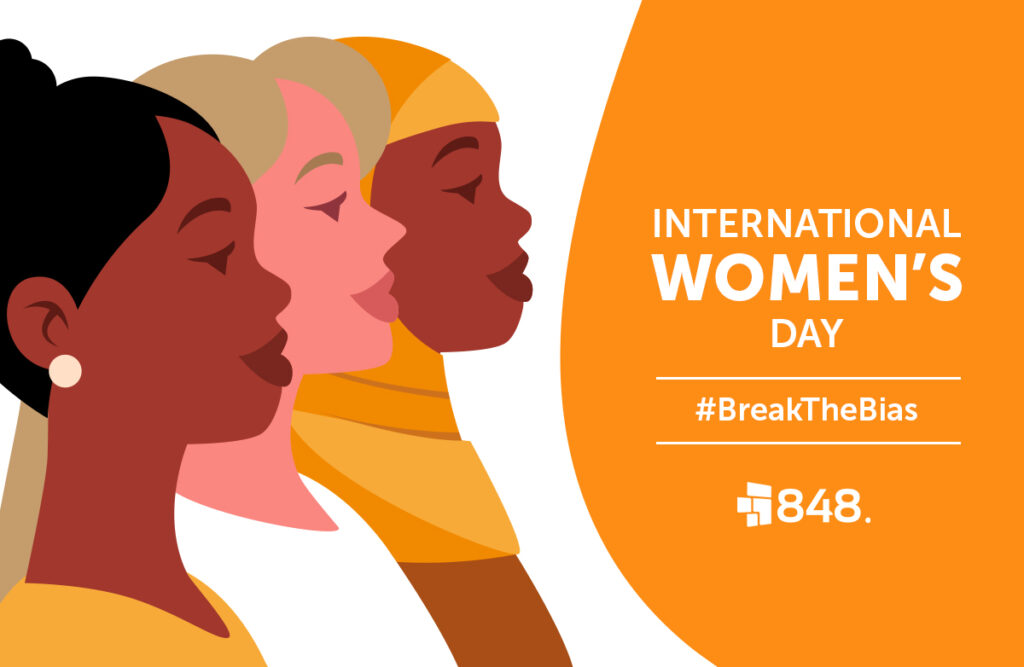In honour of International Women’s Day, we wanted to talk about closing the gender gap of women in tech.
International Women’s Day (IWD) is celebrated every year on the 8th of March. It’s a day where people from across the world unite in celebration of the social, economic, cultural, and political achievements of women. It’s also a day to raise awareness about women equality in all aspects of life, including the workplace.
This year’s theme calls for women around the world to Break the Bias. On the topic, the International Women’s Day website says:
“Imagine a gender equal world. A world free of bias, stereotypes and discrimination.”
Whether conscious or unconscious, bias makes it difficult to achieve a world that is truly gender equal. However, acknowledging that bias exists isn’t enough – action is needed to level the playing field.
At 848, we’re celebrating women in tech and gender equality in the workplace. It’s paramount that more is done to close the gender gap, break the bias, and accelerate gender parity in a male dominated industry.

Break the bias for women in tech
Gender diversity in the workplace is something organisations state they have been working towards for decades. You may think that there would be women equality in the IT and tech industry by 2022, but there isn’t.
The number of women studying or joining the tech field is still very low compared to other sectors. Isn’t that surprising considering that the first coder in the early 20th century was a woman?
For the tech industry in particular, the equal representation of women and men may still have many more decades worth of work left to go.
Let’s look at women’s representation in big tech. According to recent company figures, here are the percentage of female employees in the workforce of some of the world’s major tech companies:
In terms of leadership roles, women hold on average 26.5% of executive, senior-level and management positions. This is a percentage many tech companies match or exceed, but one that is still far from gender parity and equality.
Statistics like this not only make us question how we can encourage more women to enter the world of IT. It also highlights that more needs to be done to move women into senior and leadership positions, as both the workforce and board level have an under representation of females.
The benefits of a diverse workforce
The tech sector sadly lags behind other industries when it comes to gender equality and diversity in general. Research shows that diverse teams perform better and are more innovative. Furthermore, leaders across sectors recognise that a diverse workforce – by gender, age, race and other social factors – is good for business.
Different backgrounds, experiences and ideas ultimately help make any business or industry stronger. Early technology pioneer and computer scientist Grace Hopper once said:
“The most dangerous phrase in the language is ‘We’ve always done it this way.’”
She wasn’t just referring to outdated knowledge being adverse. Rather, she was stating that denying new solutions and ideas – especially those from women – will do more harm than good.
So, how can we boost diversity and support women in tech?
Don’t take a rushed approach when hiring
Because the tech industry is growing at such a rapid pace, diversity is often overlooked when it comes to hiring. Instead of creating a pool of candidates of different genders, races and backgrounds, some businesses rush into hiring the first candidate they can find to fulfil vacancies. This hurried approach is not only wrong, but it’s harmful to the future of the company.
Bringing more women into the interview process will ensure a diversity of ideas in the future. Women can also be overlooked for managerial positions simply because there are fewer of them in the workforce. A recent Tech Nation report that looked into diversity in UK tech companies revealed that 77% of tech director roles are filled by men.
Give credit when it’s due to retain your talent
The quit rate in the IT sector for women is 47% – that’s more than twice as high than it is for men (17%). A survey has also showed that 63% of women feel that they aren’t taken seriously, they’re being overlooked in meetings, and having their ideas being dismissed by their male colleagues.
Research shows that women tend to feel invisible at work, it’s essential to build a stronger community and ensure hard work doesn’t go unnoticed in order to retain talent.
Invest in the younger generations to make a difference in the future
The gender inequality in tech is being exacerbated from girls in education not choosing STEM subjects to study. One way of altering this is through a strong appearance of female role models in IT. According to a PwC study, 78% of students cannot name a famous female working in technology, but 75% can name a male.
It’s important to teach young people about the opportunities available to them in tech and how studying IT is beneficial. Take part in career events and partner with schools to share experiences and to encourage more females to study STEM subjects. This effort will eventually provide a wider range of talent within the IT sector.
The bottom line
The imbalance of gender diversity in IT can’t be resolved overnight. It will take years of implementing strategies to increase the number of women in tech. However, by encouraging companies to start changing their approaches and working with other initiatives, we may begin to see some wider-scale differences. Going forward, organisations should consider how their future work model could help them reach a wider and more diverse talent pool. Let’s break the bias of women in tech, close the gender gap, and accelerate gender parity in a male dominated industry.